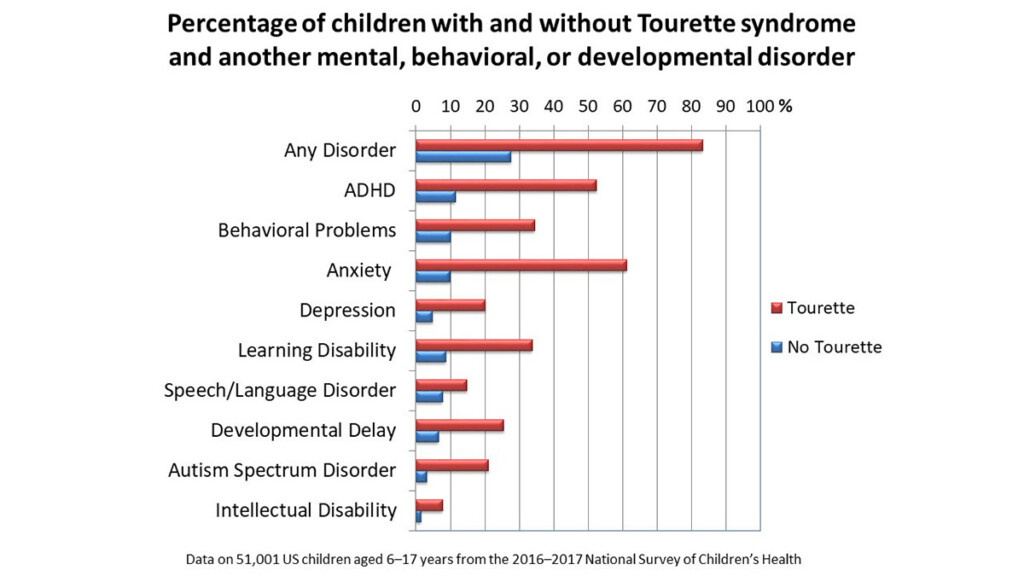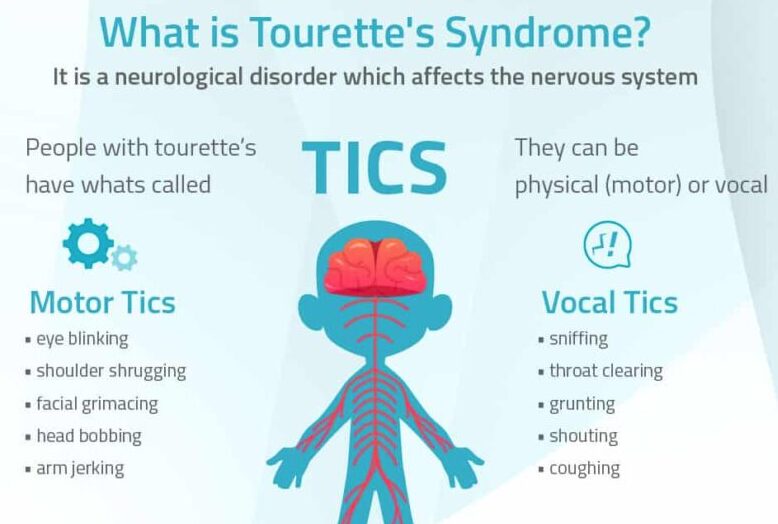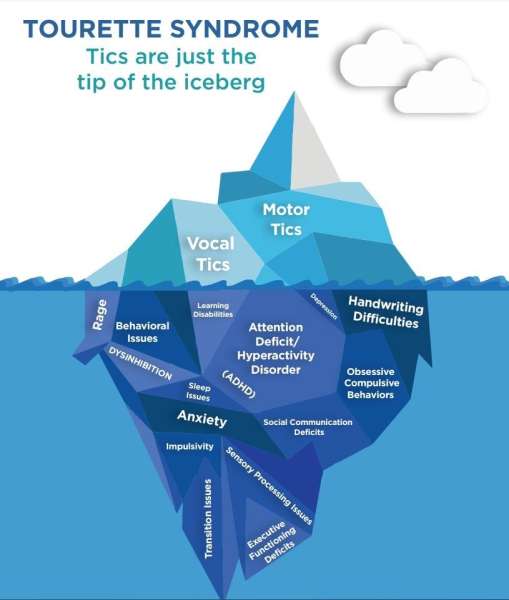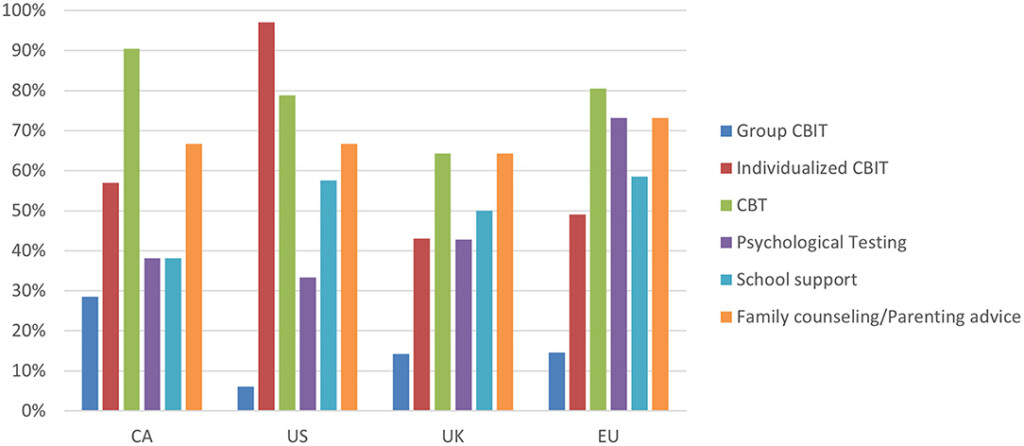Tourette’s Syndrome is a neurological disorder characterized by involuntary tics and vocalizations and often the compulsive utterance of obscenities. More simply put, it’s a brain-related condition that causes tics, which are uncontrollable movements, muscle contractions, or sounds.
The Image of Tourette’s Syndrome on Social Media
When people think of Tourette’s Syndrome, their minds most likely go straight to entertaining Instagram or Tiktok videos of people doing awkward movements and yelling funny phrases uncontrollably. While many people have to deal with this form of Tourette’s, the majority of people who suffer from this disorder deal with struggles in a far more inconspicuous manner.
The Complexities of Tourette’s Syndrome
About one percent of the United States population is estimated to have Tourette’s Syndrome, and only about one in ten people with Tourette’s suffer from coprolalia–the involuntary expression of often inappropriate language. Despite this, social media magnifies the small group, and many people have only seen the most severe side of Tourette’s Syndrome. It’s common for people with Tourette’s to suffer from other neurological conditions, and an estimated 80 percent of people with Tourette’s also deal with other disorders. These other conditions often magnify the effects of Tourette’s. For example, the compulsions that one experiences with OCD can exacerbate a tic, making it go on for an extended period of time until the “urge” to tic has been satisfied. Generally, tics worsen in times of stress, so having underlying or situational anxiety can have a negative effect on somebody’s Tourette’s.
The following data comes from the Centers for Disease Control and Prevention:
Of the children that have Tourette’s Syndrome,
- 61% had anxiety problems
- 52% had ADHD
- 34% had behavioral problems, such as oppositional defiant disorder or conduct disorder
- 34% had learning disabilities
- 26% had developmental delays
- 21% had autism spectrum disorder
- 20% had depression
- 15% had speech or language problems
- 8% had intellectual disabilities
More than one third of people with TS also have obsessive-compulsive disorder.

Why Talk About TS?
Tourette’s Syndrome affects people of all ages, but a disproportionate percentage of people with TS are adolescents. Many people struggle with minor tics throughout infancy and grow out of them by the time they’re adults, often before they make it to high school. Because TS is so prevalent among the youth, the disorder has many implications in the school environment. For this reason, it’s important to spread awareness and clear up misconceptions through a platform such as the school newspaper. Through education, we can create a more understanding and cooperative school environment for students with TS, making them feel more comfortable in high-stress, high-achieving environments.
The Nuanced World of TS
As I mentioned before, there are many variations of Tourette’s Syndrome, some far more severe or obvious than others. Broadly speaking, people with TS can experience two types of tics: motor and vocal. Motor tics, more common than vocal tics, involve bodily movements.
Examples of motor tics include:
- Eye twitching or blinking
- Neck rolling or jerking
- Nose scrunching
- Sensory compulsions – a desire to touch certain objects or surfaces
- Foot tapping
- Knuckle cracking
- Stretching
- Shoulder Shrugging
Usually, these consist of strong and repetitive muscle contractions that serve the purpose of easing an “itch”.
Additionally, vocal tics–often far more noticeable than motor tics–commonly affect people with TS. This form of Tourette’s is often projected onto social media, bringing light to those with coprolalia. Even within the category of vocal tics, there are some distinctions that can be made between differing types of tics. Some may spontaneously yell out entire words or phrases, usually associated with a memory, person or experience. Vocal tics can also assume a more subtle form.
Examples of vocal tics include:
- Throat clearing
- Humming
- Sniffling
- Grunting
- Shouting or whispering words or phrases
- Saying curse words
Most people with TS have a wide variety of tics, often both vocal and motor. Depending on the circumstances, some tics will surface more than others. In times of stress, all of someone’s tics may intensify. Oftentimes, the worst tic for a given situation (such as a vocal tic in a silent testing environment, or a motor tic when trying to sit still) is the first to surface, as the thought of suppressing that compulsion makes the “itch” that much more intense.

What Can Trigger Tics and How Do You Make Them Go Away?
Expanding on what I said previously, one’s emotions, environment, or physical state can weigh heavily on the tics that they experience. Each person with TS has different triggers that set off certain tics, but there are also some general circumstances that have a similar effect on all people with tics.
For every person I know that has Tourette’s Syndrome (including myself), the more they think about their tics the worse they get. Therefore, if someone is being made fun of for their tics or if they constantly come up in conversation, it will be harder for that person to go about their day uninterrupted or unbothered by motor and vocal urges. Once the thought of a tic enters the mind, the urge to tic grows and it can take a long time for that itch to go away.
Secondly, stress and anxiety almost always intensify tics. In fact, any strong emotion or feeling can easily trigger tics. When experiencing any kind of intense emotion (anything from depression to excitement to stress and anxiety), the brain releases neurotransmitters like dopamine and serotonin that can precipitate the urge to tic.
Finally, changes to one’s routine or environment often have a negative effect on those with TS. As creatures of habit, we naturally find comfort and equanimity in repetition and familiarity. A great way to develop a consistent, structured life is through routines. For those with TS, there is comfort in knowing the people and space that surrounds them. In growing comfortable in a routine, they can come to learn how their tics behave depending on various factors. Some may come to realize that their tics aren’t bothersome in the morning, or when they feel well-rested. For some, their tics may subconsciously worsen when walking into a certain room or building. For a student, maybe their tics could worsen when they enter the room of their least favorite class, or of the subject that they struggle with the most. Maybe being hungry plays a role in the severity of your tics, and they feel more relaxed and controlled after lunch and dinner. Often times, long periods of screen time can increase the severity of one’s tics. Interestingly, wearing earbuds or headphones can have a similar negative effect, specifically for vocal tics because you may grow unaware of your tics and they could go unchecked for periods time.
While it sucks that some circumstances worsen tics, it is comforting and calming to understand what these factors are, and it is far better to be hyperaware of your tics and what can set them off than to have no understanding of what causes them. For this reason, a routine means safety. So, when these routines get disrupted, it can cause panic, stress and anxiety, as you have no guide rails as to how your body will respond to a given situation. In this sense, the repetitive structure of a high school schedule can generally bring comfort to students with TS, but other aspects of high school life can have conversely detrimental effects on one’s tics.
Tourette’s Syndrome in High School
Yes, the predictable and organized nature of a school schedule can help with managing tics. However, the overwhelming pressure and chaos of high school–intensified within a high-achieving environment like that of Jesuit–has a disproportionately negative effect on students with TS.
Let’s think about things practically. If you’re a student taking a rigorous course load, and you are managing classes with a sport and maybe a few clubs and out of school activities, you have a lot on your plate. Focusing in on just academics, having a few tests or quizzes a week precipitates underlying feelings of stress and anticipation that can subtly worsen tics. Additionally, the stressful and silent testing environment in high school shines a spotlight on vocal tics, and, as I mentioned before, the more attention that is brought to someone’s tics, the worse they will become. For this reason, just the thought of ticking during a test and disrupting the focus of a fellow classmate can exponentially worsen the desire to tic.
With respect to athletics, competing brings about the strong emotions I spoke of previously, emotions which negatively affect those with TS. A game-like environment often precipitates extreme excitement, disappointment or pressure–all feelings that don’t mingle well with tics. For those who play sports that practice in the mornings, sleep is often sacrificed to wake up early. A lack of sleep can cause fatigue, which can intensify tics. Fatigue could also cause difficulty focusing, therefore meaning worse performance in school, and in turn, higher stress levels. Now, if you try to counter these issues by drinking coffee or energy drinks, the caffeine from these drinks often makes tic sensations much worse.
Needless to say, there is no solution. There’s no magic cure. One problem could always lead to a dozen more. Especially within a high school environment, students face circumstances where their tics will become uncontrollable, and often, overwhelming. For this reason, it is important to practice empathy, and to try and understand what a student with TS is going through.

Forms of Treatment and a Look Towards the Future
As of now, there is no perfect solution for those with Tourette’s Syndrome, but there are ways to mitigate the severity of tics. These forms of treatment vary from Deep Brain Stimulation (DBS) to medication to habit reversal counseling (a form of treatment that I underwent).
For intense cases of TS, brain surgery is available and has shown some effectiveness, but with a low rate of success, incredibly high cost and a small market of interest, that form of treatment has not received a lot of attention.
For many, medication is a more appealing way to ease the difficulties of tics. The medication interacts with neurotransmitters (as mentioned previously) to control the flow of chemicals in the brain, sometimes pacifying tics. However these medications, because they deal with chemical imbalances in the brain, often have negative side effects. They can cause depression and fatigue, and many who have used these types of medication say that they feel like a different person when it is in their system, a person with dull emotions and little energy. With these dehumanizing effects, most choose to embrace their tics, and prefer to face the difficulty that comes with TS rather than change who they are for a little bit of relief.

The most common and practical way to combat TS is through habitual therapy. This focuses on breaking down inveterate neurological responses, and building new habits of resisting tics and relaxing the mind. After years of uncontrolled and unmonitored tics, the brain becomes used to instant gratification, “scratching the itch” every time you feel a tic surfacing. With counseling, trained professionals teach those with TS to notice upcoming urges, realize the situation at hand, and counter the desire to tic with “competing responses”. These habits can be deeply, and often subconsciously, ingrained into our daily lives. Therefore, it takes hard work and consistency to realize positive change, not to mention, these sessions can be expensive, as this niche practice is only targeted towards a small minority of the general population.
To wrap things up, the world of TS is incredibly nuanced and complex. In general, people are uneducated about this neurological disorder, and social media has intensified these misconceptions, creating a false image of those who battle tics. Creating a more understanding and welcoming environment for those with TS is the fastest and most effective way to provide the community with a sense of comfort and security. Through a communal strive towards empathy, we can a level of progress insurmountable by any sort of technological or medical advancement. More specifically, within the world of high school, many students endure a silent struggle with their tics. With time, these students can learn to embrace who they are, appreciate what makes them unique and own it with pride.






